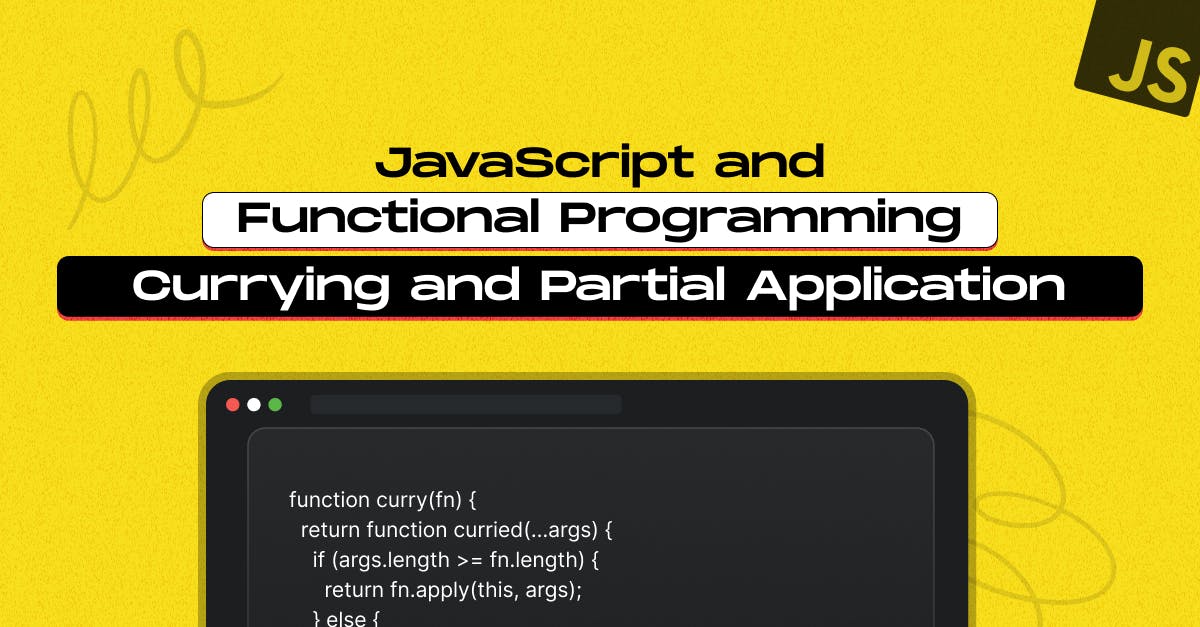March 9, 2025
JavaScript and Functional Programming: Currying and Partial Application

Md. Saad

JavaScript is a powerful programming language that supports several methods, including object-oriented and functional programming. Two fundamental ideas of functional programming are currying and partial application. These techniques allow for more modular, reusable, and readable code. This article will explore currying and partial application in JavaScript, their differences, and how to use them effectively.
What is Currying?
Currying is a functional programming approach that converts a function with multiple parameters into a series of functions, each with a single argument. The function repeatedly returns a new function until all parameters are supplied.
Example of Currying:
function curry(fn) {
return function curried(...args) {
if (args.length >= fn.length) {
return fn.apply(this, args);
} else {
return (...nextArgs) => curried(...args, ...nextArgs);
}
};
}
function add(a, b, c) {
return a + b + c;
}
const curriedAdd = curry(add);
console.log(curriedAdd(1)(2)(3)); // Output: 6Benefits of Currying:
- Code Reusability: Functions can be reused with preset values.
- Function Composition: Enhances function composition by breaking functions into smaller parts.
- Improved Readability: Helps create readable and expressive APIs.
What is Partial Application?
Partial application is a technique in which a function is pre-applied with some of its parameters before returning a new function that accepts the rest of the parameters. Unlike currying, it does not always return functions that only accept one argument at a time.
Example of Partial Application:
function partial(fn, ...presetArgs) {
return (...laterArgs) => fn(...presetArgs, ...laterArgs);
}
function multiply(a, b, c) {
return a * b * c;
}
const multiplyByTwo = partial(multiply, 2);
console.log(multiplyByTwo(3, 4)); // Output: 24Differences Between Currying and Partial Application
| Feature | Currying | Partial Application |
|---|---|---|
| Transformation |
converts a single function into many unary functions. |
Fixes some arguments and returns a new function |
| Function Calls |
Multiple function calls are needed to obtain the final result. |
Needs fewer function calls. |
| Use Case |
Ideal for practical composition and point-free style. |
Useful for pre-configuring functions with default values |
When to Use Currying and Partial Application
- Currying is useful when you need to compose functions or work with higher-order functions.
- Use Partial application when you need to prefill some arguments while leaving the rest open.
Conclusion
Currying and partial application are important strategies in functional programming for improving code modularity and reusability. Understanding the distinctions and when to use them can help you improve your JavaScript coding abilities. To see the benefits for yourself, try incorporating them into your work!
Do you have any questions about using JavaScript or need professional assistance with your web development projects? Feel free to reach out to Staticmania. We're here to help with all your development needs!
FAQ Section – JavaScript and Functional Programming: Currying and Partial Application
Currying is a functional programming technique that converts a function with multiple parameters into a series of nested functions, each taking a single argument. It helps in function composition, improves code reusability, and makes functions more modular.
Partial application pre-applies some arguments to a function and returns a new function that takes the remaining arguments. In contrast, currying transforms a function into a sequence of unary (single-argument) functions, requiring multiple calls to get the final result.
Use currying when you need better function composition, reusable functions with preset values, or when working with higher-order functions in a functional programming style.
Partial application is useful for pre-filling function arguments, improving code reusability, and making functions more flexible and adaptable. It is helpful when you need to pass commonly used arguments while leaving other parameters open.
You can create a curried function using recursion or libraries like Lodash. A basic implementation involves returning a new function that accepts one argument at a time until all arguments are supplied.
If you need function composition and point-free programming, use currying. Use partial application if you only need to pre-fill specific arguments while keeping flexibility. The choice depends on the use case and coding style.

